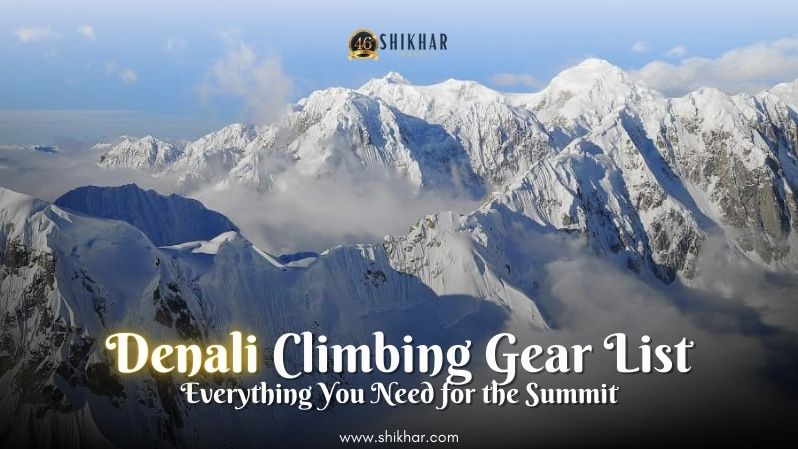Denali Climbing Gear List: Everything You Need for the Summit
Climbing Denali, North America’s highest peak, demands meticulous preparation and the right gear to ensure safety and success. The mountain’s extreme conditions require equipment that can withstand severe cold, high winds, and challenging terrain. This comprehensive gear list is designed to guide you through the essentials needed for a Denali expedition.
Why the Right Gear Matters on Denali
Denali rises to 20,310 feet (6,190 meters) and features severe cold, unpredictable storms, and long glacier travel. The gear you bring must withstand -40°F, high winds, and self-supported conditions lasting up to 21 days. Every layer, every item, must have a purpose.
Check Here: Climb Denali Expedition
Clothing: Layering for Extreme Conditions
A proper layering system is crucial to manage body temperature and protect against the elements.
Upper Body Layers
- Base Layer: Moisture-wicking synthetic or merino wool tops.
- Mid-Layer: Fleece or softshell jacket for insulation.
- Insulation Layer: High-fill down or synthetic parka.
- Shell Layer: Waterproof and breathable jacket with a hood, sized to fit over other layers.
Lower Body Layers
- Base Layer: Thermal leggings made of synthetic or wool materials.
- Mid-Layer: Fleece or softshell pants.
- Shell Layer: Waterproof and breathable pants with full-length side zips.
Insulation Layer: Down or synthetic insulated pants for high camps and summit day.
Hand Protection
- Liner Gloves: Lightweight gloves for dexterity during mild conditions.
- Insulated Gloves: Waterproof gloves with good insulation for general use.
Expedition Mittens: Heavy-duty mittens with removable liners for extreme cold
Footwear: Shoes & Socks Layer
- Mountaineering Boots: Double or triple-layer boots designed for high-altitude climbing.
- Overboots: Optional for added warmth and protection.
- Socks:
- Liner Socks: Thin synthetic socks to reduce friction.
- Insulated Socks: Thick wool or synthetic socks for warmth.
- Spare Pairs: Multiple pairs to keep feet dry and warm
Head, Face & Eye Protection
- Warm Hat: Fleece or wool hat covering the ears.
- Balaclava: For full-face protection against wind and cold.
- Buff or Neck Gaiter: Versatile accessory for neck and face coverage.
- UV Sunglasses: Glacier glasses with full coverage and side shields.
- Ski Goggles: For eye protection during storms or high winds.
Nose Guard: Optional protection against sunburn
Lighting
Headlamp: High-lumen LED headlamp with extra batteries, essential for navigation and camp activities.
Check Here: Seven Summit Expedition
Camping Equipment
- Tent: Four-season tent capable of withstanding high winds and heavy snow.
- Sleeping Bag: Rated to -40°F (-40°C), preferably down-filled for better warmth-to-weight ratio.
- Sleeping Pads: Combination of closed-cell foam and inflatable pads for insulation from the snow.
Cooking & Hydration
- Stove: Liquid fuel stove (e.g., white gas) reliable in cold temperatures.
- Fuel Bottles: Sufficient quantity for the duration of the expedition.
- Cookware: Lightweight pots, utensils, and a mug.
- Water Bottles: Insulated bottles to prevent freezing.
- Thermos: To keep liquids warm during the day
Technical Climbing Gear
- Ice Axe: General mountaineering axe suitable for glacier travel.
- Crampons: Steel crampons compatible with your boots.
- Climbing Harness: Lightweight harness with adjustable leg loops.
- Carabiners: Assorted locking and non-locking carabiners.
- Prusik Cords: For crevasse rescue and self-arrest techniques.
- Helmet: Climbing helmet that fits over a hat or balaclava
Packs & Hauling
- Expedition Backpack: 75–100 liter pack to carry all personal gear.
- Sled: For transporting heavy loads on the lower glacier.
- Summit Pack: Optional lightweight pack for summit day essentials
Personal Items
- First Aid Kit: Customized with personal medications and blister care.
- Sunscreen & Lip Balm: High SPF to protect against intense sun exposure.
- Toiletries: Toothbrush, toothpaste, biodegradable soap, and sanitation supplies.
- Repair Kit: Duct tape, sewing kit, spare buckles, and other repair items.
- Navigation Tools: Map, compass, GPS device, and altimeter.
- Communication Device: Satellite phone or personal locator beacon for emergencies
Final Tips
- Test Your Gear: Before the expedition, ensure all equipment functions properly in cold conditions.
- Pack Light but Smart: Balance weight with the necessity of each item.
- Stay Informed: Keep updated on weather forecasts and route conditions.
- Physical Preparation: Train for endurance, strength, and altitude acclimatization.
This Denali climbing gear list serves as a comprehensive guide to prepare for one of the most challenging climbs in North America. Proper equipment selection and thorough preparation are key to a safe and successful ascent.
